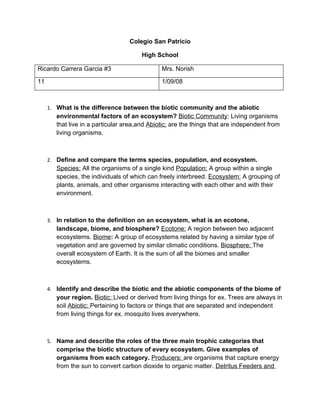
Ch 2 Carrera
- 1. Colegio San Patricio High School Ricardo Carrera Garcia #3 Mrs. Norish 11 1/09/08 1. What is the difference between the biotic community and the abiotic environmental factors of an ecosystem? Biotic Community: Living organisms that live in a particular area,and Abiotic: are the things that are independent from living organisms. 2. Define and compare the terms species, population, and ecosystem. Species: All the organisms of a single kind Population: A group within a single species, the individuals of which can freely interbreed. Ecosystem: A grouping of plants, animals, and other organisms interacting with each other and with their environment. 3. In relation to the definition on an ecosystem, what is an ecotone, landscape, biome, and biosphere? Ecotone: A region between two adjacent ecosystems. Biome: A group of ecosystems related by having a similar type of vegetation and are governed by similar climatic conditions. Biosphere: The overall ecosystem of Earth. It is the sum of all the biomes and smaller ecosystems. 4. Identify and describe the biotic and the abiotic components of the biome of your region. Biotic: Lived or derived from living things for ex. Trees are always in soil Abiotic: Pertaining to factors or things that are separated and independent from living things for ex. mosquito lives everywhere. 5. Name and describe the roles of the three main trophic categories that comprise the biotic structure of every ecosystem. Give examples of organisms from each category. Producers: are organisms that capture energy from the sun to convert carbon dioxide to organic matter. Detritus Feeders and
- 2. Decomposers: Dead plant material, the fecal wastes of animals, and dead animal bodies. Consumers: Varieties of organisms differ in size from microorganisms to big animals it includes such diverse groups as worms, fish, reptile, birds and mammals including humans. 6. How do the terms “organic” and “inorganic” relate to the biotic and abiotic components of an ecosystem? Biotic: Lived or derived from living things Organic: all living things Abiotic: Pertaining to factors or things that are separated and independent from living things Inorganic: non living things 7. Name and describe the attributes of the two categories into which all organisms can be divided. Autothrops: Produce their own food. Heterothrops: need to get food from somewhere else. 8. Give four categories of consumers in an ecosystem and the role that each plays. Herbivores: animals that eat plants Omnivores: animals that eat both plants and animals Carnivores: animals that eat meat. Parasites: plants or animals that become associated with another organism and feed on it over an extended period of time. 9. Give similarities and differences between detritus feeders and decomposers in terms of what they do, how they do it, and the kinds of organisms involved in each category. Detritus feeders: are organisms that obtain their nutrients and energy mainly by feeding on dead organic matter and Decomposers: are organisms whose feeding action results in decay organic material. 10. Differentiate between the concepts food chain, food web, and trophic levels. Food chain: the transfer of energy and material though a series of organisms as each one is fed upon by the next. Food web: the combination of all the feeding relationships that exists in an ecosystem. Trophic levels: Feeding level with respect to the primary source of energy.
- 3. 11. Relate the concept of the biomass pyramid to the fact that all heterotrophs are dependent upon autotrophic production. Much of the food tha heterothrops eat is produced by a food chain plants are autotrophs and produce their own food then a herbivore eat the plant that is heterotroph. 12. Describe three nonfeeding relationships that exist between organisms. Mutualism: the plants and insects insects benefit obtaining nectar. Symbiosis: one organism depends on another. Competitive relationship: all organisms in a “free for all” competition. 13. How is competition among different species of an ecosystem reduced? All plants require the same requirements so one can eliminate the other one to stay with them. 14. Differentiate between the two types of abiotic factors. What is the effect on a population when any abiotic factor shifts from the optimum to the limit of tolerance and beyond? What things in addition to abiotic factors may act as limiting factors? Conditions: are abiotic factors that vary in space and time but are not used up to other species. Resources: are any factors biotic or abiotic that are consumed by organisms. 15. Describe how differences in climate cause the Earth to be distributed into six major biomes. Different temperature creates the different bioms because each biom needs different temperature. 16. What are three situations that might cause microclimates to develop within an ecosystem? Temperature
- 4. 17. What is significant about each of the following revolutions: Neolithic, Industrial, and environmental? Neolithic: Natural ecosystems have existed and perpetuated themselves on Earth for hundreds of millions of years, while humans are relative newcomers on this scene. Industrial: with the birth of modern science and technology in the seventeenth and eighteenth centuries, the human population was on threshold of another revolution the industrial revolution. Environmental: recognizing that all of the changes that will be required to move the human system from its present state to one that is sustainable are indeed revolutionary.